Japan Tourism Sites offer a captivating blend of ancient traditions and modern marvels, making it a sought-after destination for global travelers. Let SIXT.VN guide you through Japan’s most iconic attractions, from serene temples to bustling cityscapes. Discover seamless travel solutions, including airport transfers, hotel bookings, and expertly crafted tour packages, ensuring an unforgettable Japanese journey. Explore cultural experiences, historical landmarks, and vibrant urban adventures.
1. Discovering the Majesty of Mount Fuji
Mount Fuji, an iconic Japan tourism site, is undeniably Japan’s most recognizable landmark and the country’s highest mountain peak, towering 3,776 meters. This majestic mountain, part of the Fuji-Hakone-Izu National Park, is a pilgrimage site climbed by over a million people each summer to watch the sunrise from its summit.
- Pilgrimage and Summit Views: Climbing Mount Fuji is a revered act, drawing numerous visitors annually.
- Accessibility: Most climbers start at the 5th Station, a more manageable point for the ascent.
- Cultural Significance: Recognized by UNESCO, Mount Fuji is celebrated in art and literature, symbolizing Japan’s cultural heritage.
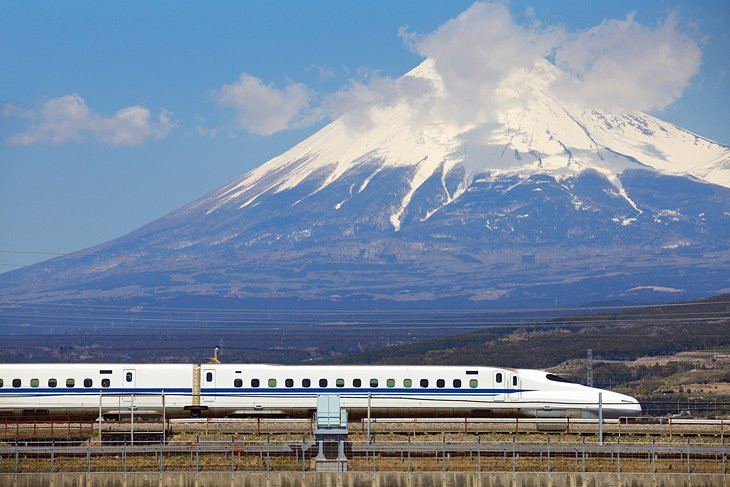 Mount Fuji
Mount Fuji
2. Exploring Imperial Tokyo: A Blend of History and Modernity
The Imperial Palace, with its 17th-century parks, walls, and moats, is a must-see Japan tourism site in Tokyo. While the palace is largely closed to the public, visitors can stroll the grounds and explore the East Higashi-Gyoen Garden. The Ginza shopping district offers Kabuki-za Theatre and Shimbashi Enbujo Theatre for traditional performances.
- Historical Significance: The Imperial Palace represents Japan’s rich history and imperial traditions.
- Cultural Experiences: Ginza’s theaters provide insights into traditional Japanese arts like Kabuki and Azuma-odori dances.
- Must-See Attractions: The Nijubashi Bridge offers a romantic view, reflecting Japan’s artistic and architectural beauty.
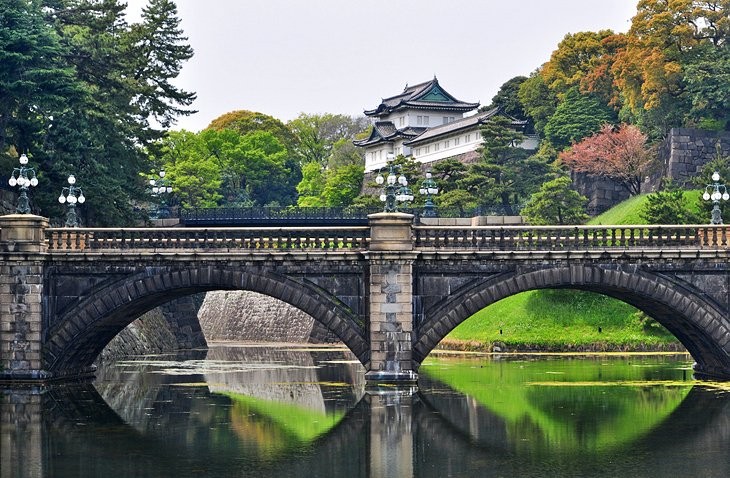 Imperial Palace and Nijubashi Bridge
Imperial Palace and Nijubashi Bridge
3. Reflecting at Hiroshima Peace Memorial Park
Hiroshima Peace Memorial Park, a significant Japan tourism site, commemorates the victims of the 1945 atomic bombing and stands as a symbol of lasting peace. Visited by over a million people annually, the park features the Peace Memorial Museum, Memorial Cenotaph, Flame of Peace, and Atom Bomb Dome.
- Historical Importance: The park serves as a poignant reminder of the atomic bombing and its impact.
- Educational Exhibits: The Peace Memorial Museum offers exhibits on world peace and the events of that fateful day.
- Symbol of Peace: Hiroshima’s transformation into a symbol of peace underscores Japan’s commitment to global harmony.
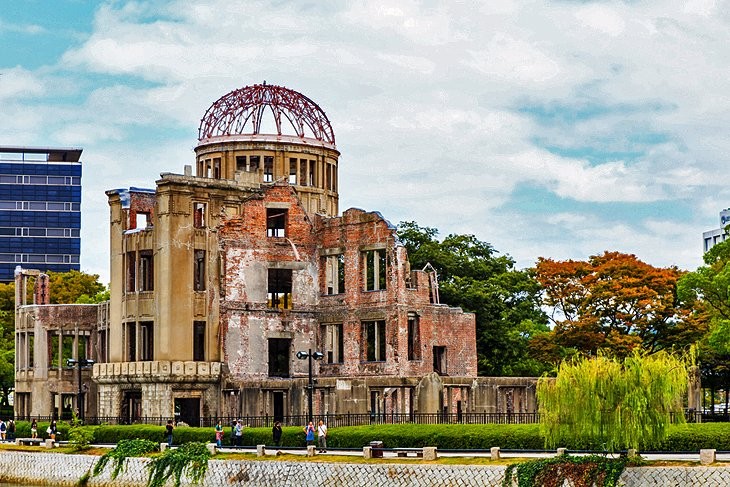 Hiroshima Peace Memorial Park
Hiroshima Peace Memorial Park
4. Discovering the Ancient Charm of Historic Kyoto
Kyoto, one of Japan’s most visited cities and a prominent Japan tourism site, attracts over 10 million visitors annually with its well-preserved streets and architecture. Explore the Golden Pavilion (Kinkaku-ji), Nijo Castle, Kyoto Imperial Palace, and Arashiyama Bamboo Grove.
- Cultural Center: Kyoto’s museums and art galleries showcase important sculptures, paintings, and art forms.
- Architectural Marvels: The Golden Pavilion, clad in gold leaf, exemplifies Kyoto’s exquisite architecture.
- Natural Beauty: The Arashiyama Bamboo Grove offers a serene escape into nature.
 Bamboo forest in Kyoto
Bamboo forest in Kyoto
5. The Island Shrine of Itsukushima, Miyajima
Miyajima, known as Japan’s Shrine Island and a key Japan tourism site, is a short ferry ride from Hiroshima. It is famous for the Itsukushima Shrine, a Shinto temple dedicated to the daughters of the wind god Susanoo. The Great Floating Gate (O-Torii) and the shrine’s halls appear to float on water at high tide.
- Historical Significance: Dating back to the eighth century, the shrine reflects Japan’s ancient religious traditions.
- Architectural Wonder: The shrine’s buildings rise out of the bay’s waters, creating a stunning visual effect.
- Cultural Performances: Traditional dances and musical performances entertain visitors.
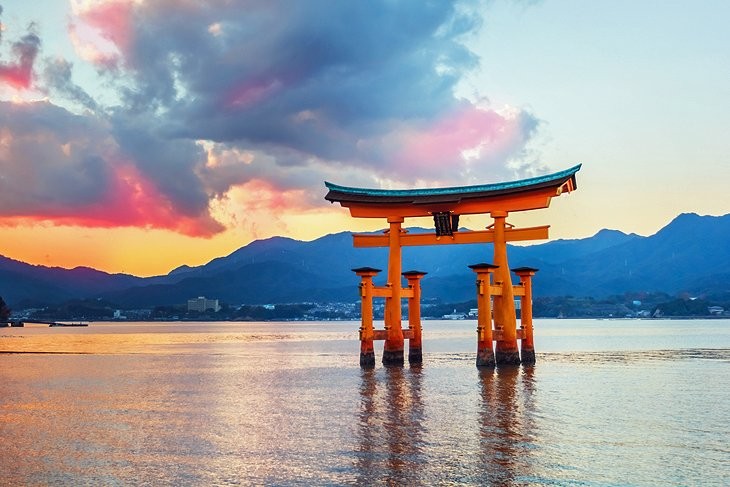 The Island Shrine of Itsukushima
The Island Shrine of Itsukushima
6. Temple City: Exploring Historic Nara
Nara, a hub of Japanese culture and a significant Japan tourism site, is home to historic buildings, national treasures, and works of art. Visit the Kofuku-ji Temple and the Todai-ji (Great East Temple), famous for its bronze statue of the Great Buddha (Daibutsu).
- Cultural Heritage: Nara’s temples and historic streets showcase Japan’s rich cultural heritage.
- Architectural Highlights: The Todai-ji Temple features the Great South Gate (Nandaimon) and the Hall of the Great Buddha.
- Historical Significance: Nara’s role as a cultural center for centuries underscores its importance in Japanese history.
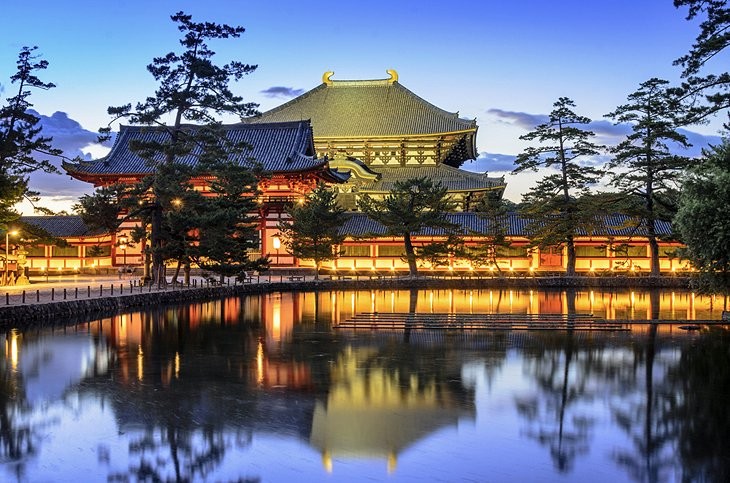 Temple City: Historic Nara
Temple City: Historic Nara
7. Osaka Castle: A Symbol of Japanese Warrior Spirit
Osaka Castle, built in 1586 by Toyotomi Hideyoshi and a prominent Japan tourism site, was the largest and most important fortress in the country. The main tower offers displays detailing the history of the castle and city, with superb views over Osaka. Visit Hokoku Shrine and Shitennō-ji Temple.
- Historical Importance: Osaka Castle represents the power and ambition of Japanese warriors.
- Architectural Grandeur: The five-story main tower is built on a 14-meter-tall stone base.
- Cultural Sites: Shitennō-ji Temple, Japan’s first Buddhist temple, features a five-story pagoda.
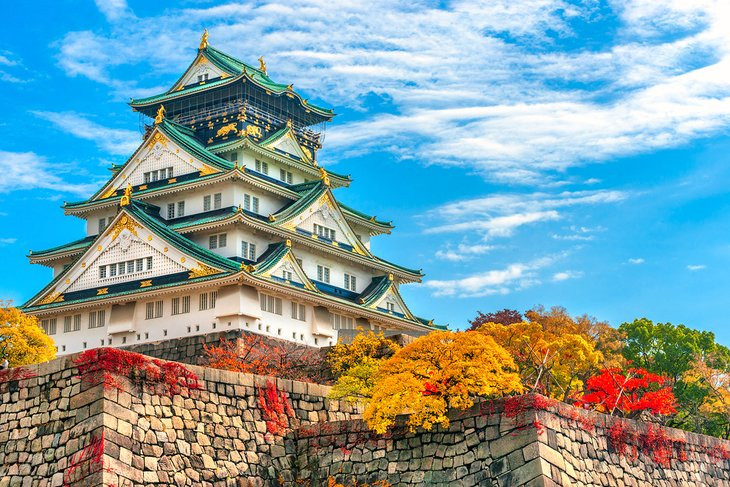 Osaka Castle with autumn leaves
Osaka Castle with autumn leaves
8. Chūbu-Sangaku National Park and the Japanese Alps: Nature’s Majesty
Chūbu-Sangaku National Park, a spectacular Japan tourism site in central Honshu, features the Hida Mountains, or Japanese Alps. This region offers high peaks, diverse flora and fauna, and hot springs. Popular activities include walking, climbing, and skiing.
- Natural Beauty: The Japanese Alps offer stunning landscapes similar to the Alps of Central Europe.
- Outdoor Activities: The park is ideal for walking, climbing in summer, and skiing in winter.
- Flora and Fauna: The park’s diverse ecosystem includes rare ptarmigan and mountain antelopes.
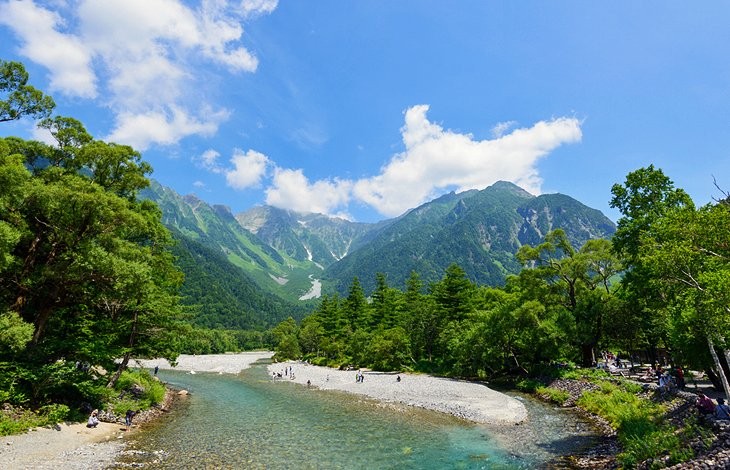 Chūbu-Sangaku National Park and the Japanese Alps
Chūbu-Sangaku National Park and the Japanese Alps
9. The Atsuta Shrine, Nagoya: A Spiritual Haven
The Atsuta Shrine in Nagoya, the most important Shinto shrine in Japan and a significant Japan tourism site, attracts over five million visitors annually. Established in the first century, it houses the “grass-mowing sword” (kusanagi-no-tsurugi). Also visit Nagoya Castle.
- Spiritual Significance: The shrine is a major center for Shinto worship and pilgrimage.
- Historical Artifacts: The “grass-mowing sword” is one of Japan’s most revered Imperial insignia.
- Cultural Exploration: Nagoya Castle features art treasures and panoramic views of the city.
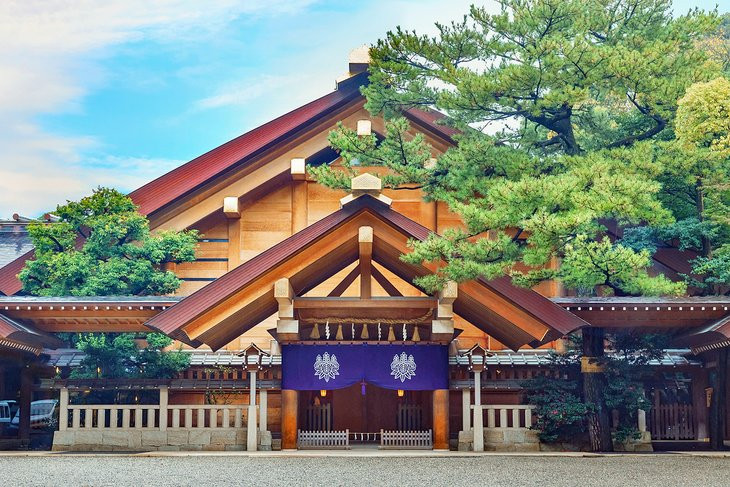 The Atsuta Shrine in Nagoya, Japan
The Atsuta Shrine in Nagoya, Japan
10. Fukuoka Castle Ruins and the City’s Ancient Festivals
The ruins of Fukuoka Castle, built in the early 1600s and a notable Japan tourism site, are in Maizuru Park. Visitors enjoy leafy walking trails and scenic lookouts. Fukuoka is known for Hakata Gion Yamakasa, a 700-year-old celebration in July. Also visit Canal City Hakata.
- Historical Remains: The ruins offer a glimpse into the past grandeur of Fukuoka Castle.
- Cultural Festivals: Hakata Gion Yamakasa draws millions with its parades and races.
- Modern Attractions: Canal City Hakata features shops, hotels, restaurants, and a canal.
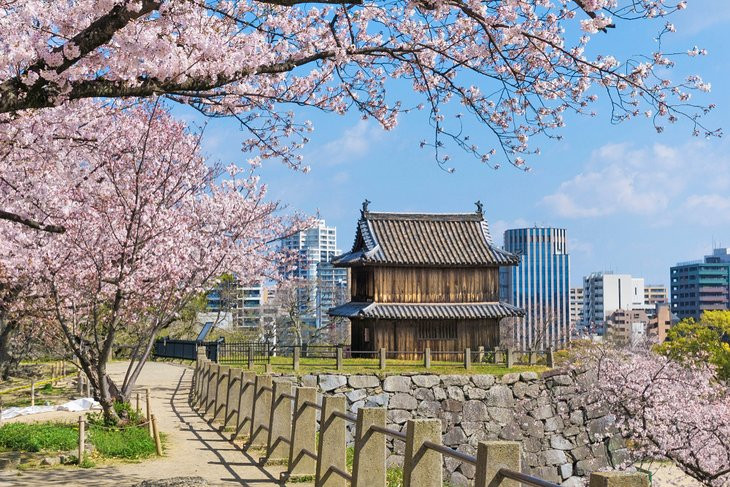 The ruins of Fukuoka Castle in Maizuru Park
The ruins of Fukuoka Castle in Maizuru Park
11. Sapporo, Hokkaido: A Hub of Cultural Activity
Sapporo, Hokkaido’s largest city and a compelling Japan tourism site, offers cultural events, festivals, and a distinctive culinary style. Visit Odori Park, Sapporo TV Tower, and Mount Moiwa for panoramic views. The Sapporo Snow Festival in February attracts over two million revelers.
- Urban Exploration: Sapporo’s downtown area features Odori Park and the Sapporo TV Tower.
- Scenic Views: Mount Moiwa offers incredible views over the city.
- Winter Destination: The Sapporo Snow Festival is a popular winter event.
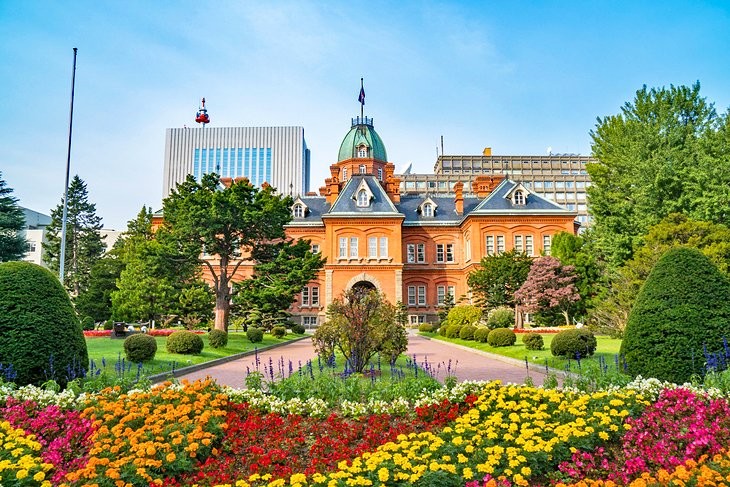 Sapporo, Hokkaido
Sapporo, Hokkaido
12. Fushimi Inari-taisha Shrine, Kyoto: A Vermilion Spectacle
Fushimi Inari-taisha Shrine, a key Japan tourism site in southern Kyoto, is famous for thousands of scarlet-colored gates arching over trails. The shrine is dedicated to Inari, the Shinto god of rice. Visitors can hike to the top of Mt. Inari.
- Spiritual Significance: The shrine is dedicated to Inari, one of the most important Shinto gods.
- Iconic Gates: Thousands of vermilion gates create a stunning visual experience.
- Hiking Trails: Visitors can hike to the top of Mt. Inari, passing smaller shrines and eateries.
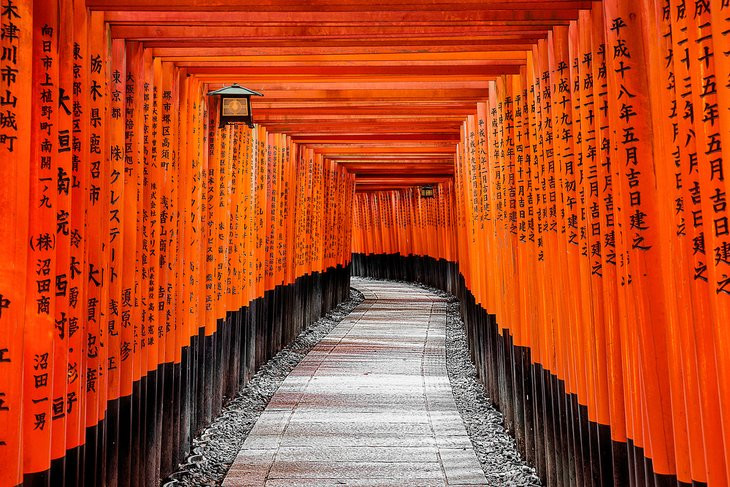 Fushimi Inari-taisha Shrine
Fushimi Inari-taisha Shrine
13. Koyasan Okunoin: A Sacred Cemetery
Koyasan Okunoin, a popular pilgrimage spot and a unique Japan tourism site, holds the mausoleum of Kobo Daishi, the founder of Shingon Buddhism. Visitors cross the Ichinohashi Bridge and pass over 200,000 tombstones.
- Spiritual Journey: Pilgrims visit the mausoleum to ask for salvation.
- Historical Significance: Kobo Daishi is one of the most important figures in Japan’s Buddhist history.
- Sacred Site: The cemetery is one of the most sacred places in Japan.
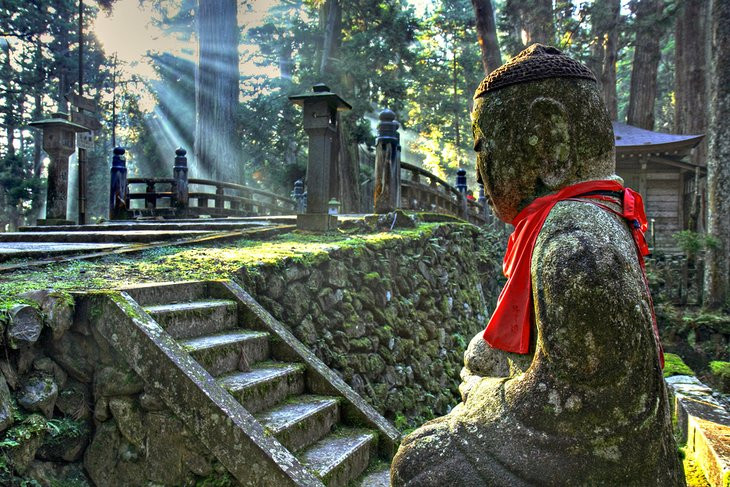 Koyasan Okunoin
Koyasan Okunoin
14. Kiyomizu-Dera, Kyoto: The Pure Water Temple
Kiyomizu-Dera, the Pure Water Temple and a significant Japan tourism site in Kyoto, was built in 780 CE on the grounds of the Otowa Waterfall. This UNESCO World Heritage Site is known for its wooden stage overlooking Kyoto’s rooftops.
- Historical Significance: The temple was originally built as part of the Hosso sect of Buddhism.
- Scenic Views: The wooden stage offers beautiful views of Kyoto.
- Cultural Sites: Visitors can explore the Jishu Shrine and the Otowa Waterfall.
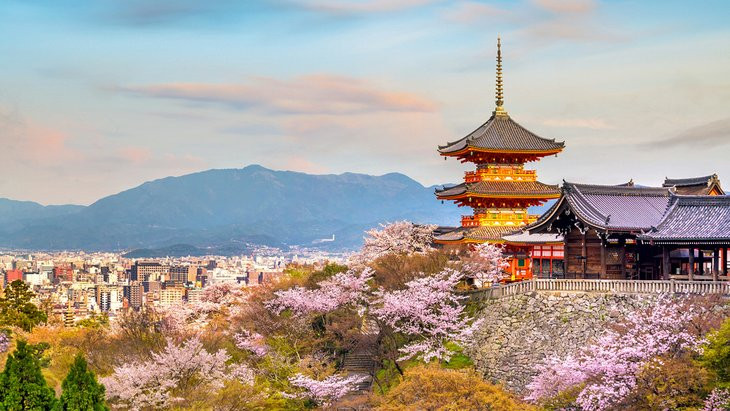 Kiyomizu-Dera temple during cherry blossom season
Kiyomizu-Dera temple during cherry blossom season
15. Shinjuku Gyoen National Garden, Tokyo: An Oasis of Tranquility
Shinjuku Gyoen National Garden, a beautiful Japan tourism site in Tokyo, features sprawling green spaces, walking paths, and floral displays. The park includes Japanese, English, and French landscape styles.
- Historical Background: The park was built during Japan’s Edo Period.
- Diverse Gardens: The park features three different styles of garden.
- Urban Escape: The garden offers a tranquil escape in the heart of Tokyo.
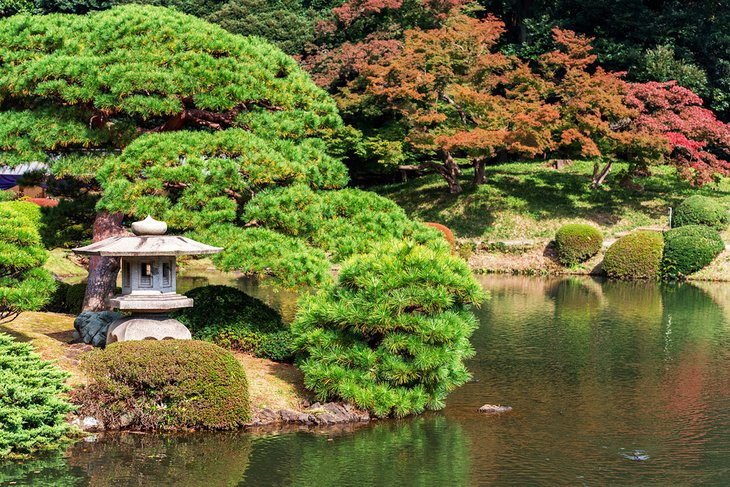 Shinjuku Gyoen park
Shinjuku Gyoen park
16. Hakone Open-Air Museum, Hakone: Art Amidst Nature
Hakone Open-Air Museum, a stunning Japan tourism site in Hakone, is a sculpture park spreading over 17 acres. It features over 100 sculptures and an indoor exhibit with a collection of Picasso’s works.
- Artistic Displays: The museum features sculptures set against the backdrop of mountains.
- Picasso Collection: The indoor exhibit includes oil paintings, prints, ceramics, and sculptures by Picasso.
- Scenic Location: Hakone is known for its mountains and hot spring resorts.
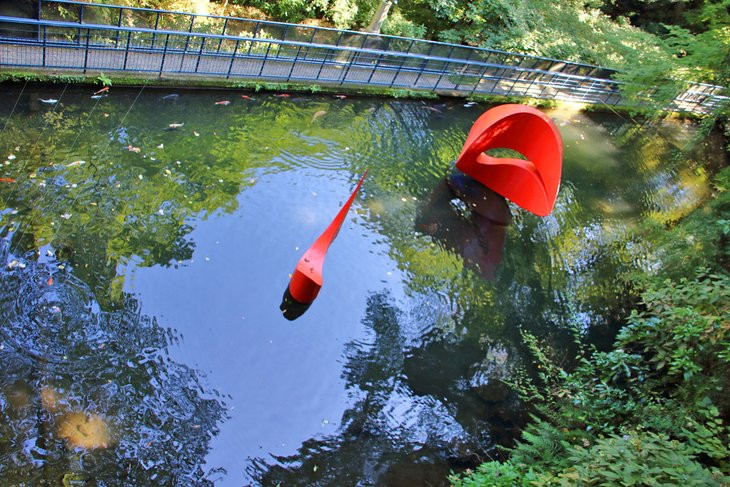 Hakone Open-Air Museum
Hakone Open-Air Museum
17. Naritasan Shinsho-ji, Narita: A Journey Back in Time
Naritasan Shinsho-ji Temple, a popular Japan tourism site dating back over 1,000 years, is one of the most popular Buddhist temples in Japan. The temple grounds include pagodas, a park, and main halls. The approach to the temple is lined with restaurants and handicraft stores.
- Historical Significance: The temple was built to protect a statue of the Buddhist god, Fudo Myoo.
- Cultural Experience: The journey to the temple offers a glimpse into the past.
- Architectural Marvels: The temple complex includes several different style pagodas.
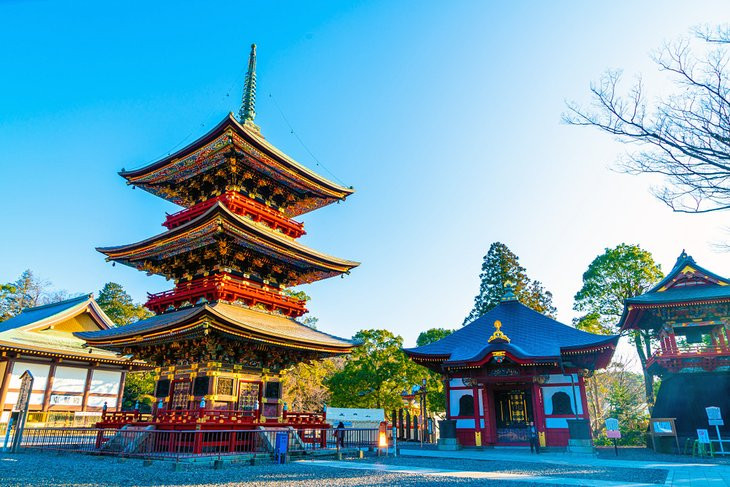 Naritasan Shinsho-ji temple
Naritasan Shinsho-ji temple
18. Okinawa Churaumi Aquarium: A Marine Wonderland
Okinawa Churaumi Aquarium, widely considered the best in Japan and a fascinating Japan tourism site, is known for its Kuroshio Tank with whale sharks and manta rays. Other attractions include a deep water exhibit and pools with dolphins, sea turtles, and manatees.
- Marine Life: The aquarium showcases about 60 different species of animals.
- Kuroshio Tank: The massive tank features whale sharks and manta rays.
- Tropical Environment: Okinawa offers beautiful beaches and swaying palm trees.
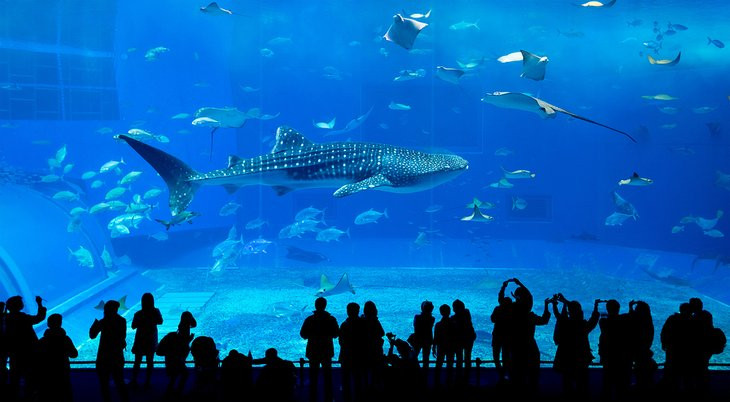 Whale shark in the Okinawa Churaumi Aquarium
Whale shark in the Okinawa Churaumi Aquarium
19. Matsumoto Castle, Nagano: A Glimpse into History
Matsumoto Castle, built from 1592 to 1614 and a significant Japan tourism site in Nagano, is one of the most complete and mesmerizing castles in Japan. The castle has maintained its wooden interiors, offering a true historic feel.
- Historical Significance: The castle is one of five castles designated as “National Treasures of Japan.”
- Wooden Interiors: Matsumoto Castle has maintained its wooden interiors, giving a true historic feel to the experience.
- Scenic Beauty: The castle is especially beautiful in the spring with cherry blossoms.
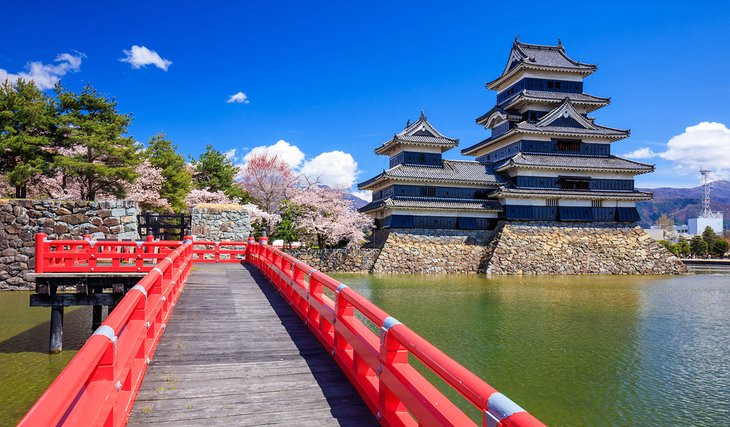 Matsumoto Castle
Matsumoto Castle
20. Arashiyama Monkey Park, Kyoto: A Unique Wildlife Encounter
Arashiyama Monkey Park, located in Kyoto’s Arishayama section and a delightful Japan tourism site, offers sweeping views of the city and a troop of over 120 Japanese macaque monkeys. Visitors can feed the monkeys with food purchased at the park.
- Wildlife Experience: Visitors can get up close and personal with Japanese macaque monkeys.
- Scenic Views: The park provides a great view of Kyoto and the mountains.
- Outdoor Activity: The hike up the mountain is a rewarding experience.
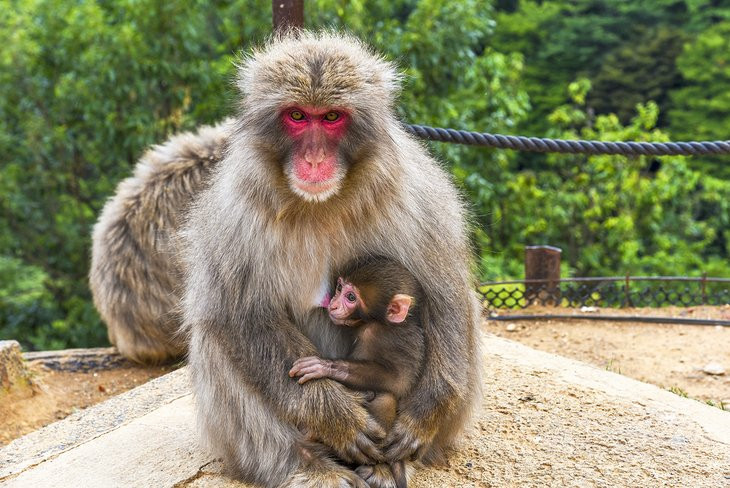 Arashiayama Monkey Park
Arashiayama Monkey Park
21. Kenrokuen Garden, Kanazawa: A Masterpiece of Landscape Design
Kenrokuen Garden, a perfectly manicured Japan tourism site in Kanazawa, is considered one of the most beautiful gardens in Japan. Designed around the six essentials of a perfect garden, it features pools, bridges, teahouses, and artfully placed stones.
- Landscape Design: The garden is designed around the six essentials of a perfect garden.
- Scenic Features: Visitors will pass by pools, brooks, bridges, and teahouses.
- Seasonal Beauty: The park is beautiful in spring with cherry blossoms and in fall with autumn colors.
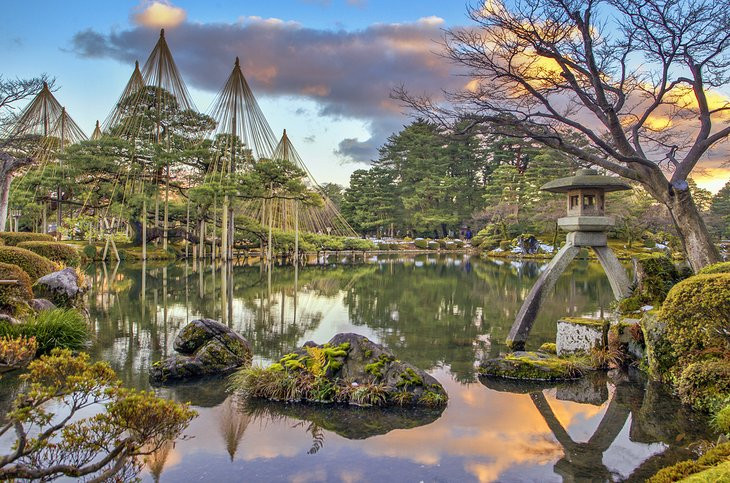 Kenrokuen Garden in Kanazawa
Kenrokuen Garden in Kanazawa
Maximizing Your Visit to Japan: Essential Tips
To make the most of your journey through Japan tourism sites, consider these essential tips:
| Tip | Description |
|---|---|
| Shoulder Season Travel | Explore Japan during quieter months for fewer crowds and unique seasonal experiences. |
| Efficient Public Transport | Use Japan’s modern railway system, including the Shinkansen Bullet Train, for easy travel. |
| Japan Rail Pass | Purchase a Japan Rail Pass or book rail tours in advance to save on travel costs. |
According to research from the Japan National Tourism Organization in 2023, utilizing the Shinkansen Bullet Train enhances travel efficiency by 60%, allowing tourists to visit multiple sites in a shorter time frame.
Best Time to Visit Japan: Seasonal Insights
Japan offers unique experiences throughout the year. The best time to visit Japan tourism sites depends on your interests:
| Season | Highlights | Temperature Range |
|---|---|---|
| Spring | Sakura (cherry blossoms) transform Japan. Mild weather, but temperatures vary. | 4°C to mid-teens°C (Northern to Southern cities)Single digits in the early mornings and at night13 to 15 degrees during the day in Tokyo |
| Summer | Hot, humid, and often wet. Great for mountain escapes. Typhoons possible. | High 20s to 30s°C |
| Fall | Cooler weather, autumn colors, discounted prices. Drier than spring. | Varies, generally mild |
| Winter | Cold in many places, mild in others. Ski resorts are great in January and February. | -10°C to 15°C (Sapporo to Naha) |
SIXT.VN: Your Gateway to Unforgettable Japan Tourism Sites
Planning a trip to Japan can be overwhelming, but SIXT.VN is here to make your journey seamless and unforgettable. From booking airport transfers to securing hotel accommodations and arranging expertly guided tours, SIXT.VN offers comprehensive travel solutions tailored to your needs.
Comprehensive Travel Solutions
- Airport Transfers: Enjoy hassle-free transportation from the airport to your hotel.
- Hotel Bookings: Choose from a wide selection of hotels to suit your budget and preferences.
- Guided Tours: Explore Japan’s iconic sites with knowledgeable local guides.
Why Choose SIXT.VN?
- Convenience: Book all your travel needs in one place.
- Reliability: Trust in our dependable services for a stress-free experience.
- Expertise: Benefit from our in-depth knowledge of Japan tourism sites.
SIXT.VN is dedicated to providing exceptional service and ensuring your trip to Japan is nothing short of spectacular.
Contact Information
- Address: 260 Cau Giay, Hanoi, Vietnam
- Hotline/Whatsapp: +84 986 244 358
- Website: SIXT.VN
FAQ About Japan Tourism Sites
1. What are the most popular Japan tourism sites?
The most popular Japan tourism sites include Mount Fuji, Imperial Palace, Hiroshima Peace Memorial Park, Historic Kyoto, and the Island Shrine of Itsukushima.
2. What is the best time to visit Japan for cherry blossoms?
The best time to visit Japan for cherry blossoms is during the months of March and April.
3. How can I get around Japan efficiently?
Japan’s modern railway system, including the Shinkansen Bullet Train, provides efficient transportation between cities.
4. What is the significance of the Hiroshima Peace Memorial Park?
The Hiroshima Peace Memorial Park commemorates the victims of the atomic bombing and stands as a symbol of lasting peace.
5. What are some unique cultural experiences in Kyoto?
Unique cultural experiences in Kyoto include exploring the Golden Pavilion (Kinkaku-ji) and visiting the Arashiyama Bamboo Grove.
6. What is the best way to book travel services in Japan?
SIXT.VN offers comprehensive travel solutions, including airport transfers, hotel bookings, and guided tours, making your trip planning seamless.
7. What is the Atsuta Shrine in Nagoya known for?
The Atsuta Shrine is the most important Shinto shrine in Japan and houses the “grass-mowing sword” (kusanagi-no-tsurugi).
8. What activities are popular in Chūbu-Sangaku National Park?
Popular activities in Chūbu-Sangaku National Park include walking, climbing in summer, and skiing in winter.
9. What is the significance of Fushimi Inari-taisha Shrine in Kyoto?
Fushimi Inari-taisha Shrine is famous for its thousands of scarlet-colored gates arching over trails and is dedicated to Inari, the Shinto god of rice.
10. What is unique about Koyasan Okunoin?
Koyasan Okunoin is a sacred cemetery and pilgrimage spot holding the mausoleum of Kobo Daishi, the founder of Shingon Buddhism.
Conclusion
Japan tourism sites offer an unparalleled blend of history, culture, and natural beauty. Whether you’re exploring ancient temples, bustling cityscapes, or serene gardens, Japan promises an unforgettable travel experience. With SIXT.VN, planning your trip is easier than ever. From comprehensive travel solutions to expert guidance, SIXT.VN ensures your journey through Japan’s most iconic destinations is seamless, memorable, and truly spectacular. Embark on your Japanese adventure today and discover the wonders that await!



